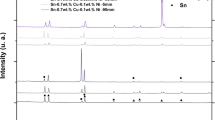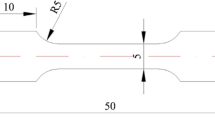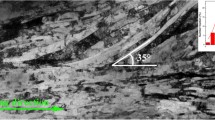Abstract
Mechanical strength and electrical conductivity are the most important properties of conducting metallic materials used in electrical engineering. Today, there is a growing need in this field for innovative conductor materials with improved properties. Meanwhile, the main issue is that high electrical conductivity and high strength are usually mutually exclusive due to physical nature of these properties. Alloying of pure metals results in significant increase of their mechanical strength, whereas electrical conductivity dramatically drops due to the scattering of electrons at solutes and precipitates. Recent studies have shown that intelligent nanostructural design in Al, Cu, and their alloys can improve combination of high mechanical strength with enhanced electrical conductivity. It was demonstrated that mechanical strength and electrical conductivity of these materials are primarily controlled by their microstructure, of which grain size, morphology of second phases, and their distribution, as well as dislocation structure, are the most important parameters. Rapid development of the state-of-the-art methods for the microstructural characterization at nano- and atomic scale has allowed a deeper insight into microstructure–properties relationship. The approach of intelligent nanostructural design of Al and Cu alloys has even enabled to increase the material strength with simultaneous improvement of its electrical conductivity. In this case, recent works on nanostructuring alloys by severe plastic deformation are of special interest, which gives rise to fundamental questions dealing with new mechanisms of strength and electrical conductivity as well as innovation potential of practical application of nanostructured materials. These issues are considered and discussed in the present progress article.










Similar content being viewed by others
Notes
Electrical resistivity (ρ) is also used to specify the electrical characteristics of a material. It is simply the reciprocal of the conductivity, or ρ = 1/Ω.
References
Rossiter PL (1987) The electrical resistivity of metals and alloys. Cambridge University Press, Cambridge
Dugdale JS (1977) The electrical properties of metals and alloys. Arnold, London
Cahn RW, Haasen P, Kramer EJ (2005) Materials science and technology, vol 8/9. Wiley, New York, pp 282–285
Haasen P (1996) In: Cahn RW, Haasen P (eds) Physical metallurgy, vol 3. Elsevier Science B.V, The Netherlands, pp 2009–2073
Kelly A, Nicholson RB (eds) (1971) Strengthening methods in crystals. Elsevier, England
Ashby MF (1970) The deformation of plastically non-homogeneous materials. Philos Mag 21:399–424
Hall EO (1951) The deformation and aging of mild steel. Proc Phys Soc B. 64:747–753
Petch NJ (1953) The cleavage strength of polycrystals. J Iron Steel Inst 174:25–28
Kamikawa N, Huang X, Tsuji N, Hansen N (2009) Strengthening mechanisms in nanostructured high-purity aluminium deformed to high strain and annealed. Acta Mater 57:4198–4208
Asgharzadeh H, Simchi A, Kim HS (2011) Microstructural features, texture and strengthening mechanisms of nanostructured AA6063 alloy processed by powder metallurgy. Mater Sci Eng A 528:3981–3989
Asgharzadeh H, Simchi A, Kim HS (2011) Microstructure and mechanical properties of oxide-dispersion strengthened Al6063 alloy with ultra-fine grain structure. Metall Mater Trans A 42:816–824
Topping TD, Ahn B, Li Y, Nutt SR, Lavernia EJ (2012) Influence of process parameters on the mechanical behavior of an ultrafine-grained Al alloy. Metall Mater Trans A 43:505–519
Kasap S, Capper P (eds) (2006) Springer handbook of electronic and photonic materials. Springer, Würzburg
Matthiessen A, Vogt C (1864) On the influence of temperature on the electric conducting-power of alloys. Philos Trans R Soc Lond 154:167–200
Botcharova E, Freudenberger J, Schultz L (2006) Mechanical and electrical properties of mechanically alloyed nanocrystalline Cu–Nb alloys. Acta Mater 54:3333–3341
Miyajima Y, Komatsu SY, Mitsuhara M, Hata S, Nakashima H, Tsuji N (2010) Change in electrical resistivity of commercial purity aluminium severely plastic deformed. Philos Mag 90:4475–4488
Lu L, Shen Y, Chen X, Qian L, Lu K (2004) Ultrahigh strength and high electrical conductivity in copper. Science 304:422–426
Zhang Y, Li YS, Tao NR, Lu K (2007) High strength and high electrical conductivity in bilk nanograined Cu embedded with nanoscale twins. Appl Phys Lett 91:211901
Gleiter H (1989) Nanocrystalline materials. Prog Mater Sci 33:223–315
Zhang DL (2004) Processing of advanced materials using high-energy mechanical milling. Prog Mater Sci 49:537–560
Witkin DB, Lavernia EJ (2006) Synthesis and mechanical behavior of nanostructured materials via cryomilling. Prog Mater Sci 51:1–60
Valiev RZ, Islamgaliev RK, Alexandrov IV (2000) Bulk nanostructured materials from severe plastic deformation. Prog Mater Sci 45:103–189
Valiev RZ, Zehetbauer MJ, Estrin Y, Hoeppel HW, Ivanisenko Y, Hahn H, Wilde G, Roven HJ, Sauvage X, Langdon TG (2007) The innovation potential of bulk nanostructured materials. Adv Eng Mater 9:527–533
Estrin Y, Vinogradov A (2013) Extreme grain refinement by severe plastic deformation: a wealth of challenging science. Acta Mater 61:782–817
Langdon TG (2013) Twenty-five years of ultrafine-grained materials: achieving exceptional properties through grain refinement. Acta Mater 61:7035–7059
Valiev RZ, Sabirov I, Zhilyaev AP, Langdon TG (2012) Bulk nanostructured metals for innovative applications. JOM 64:1134–1142
Zhilyaev AP, Langdon TG (2008) Using high-pressure torsion for metal processing: fundamentals and applications. Prog Mater Sci 53:893–979
Valiev RZ, Langdon TG (2006) Principles of equal channel angular pressing as a processing tool for grain refinement. Prog Mater Sci 51:881–981
Saito Y, Utsunomiya H, Sakai T, Hong RG (1998) Ultra-fine grained bulk aluminum produced by accumulative roll-bonding (ARB) process. Scr Mater 39:1221–1227
Lewandowska M, Pachla W, Kurzydlowski KJ (2007) Recent development in grain refinement by hydrostatic extrusion. Int J Mater Res 98:172–177
Zhao YH, Liao XZ, Cheng S, Ma E, Zhu YT (2006) Simultaneously increasing the ductility and strength of nanostructured alloys. Adv Mater 18:2280–2285
Sabirov I, Murashkin MYu, Valiev RZ (2013) Nanostructured aluminium alloys produced by severe plastic deformation: new horizons in development. Mater Sci Eng A 560:1–24
Valiev RZ, Murashkin MYU, Sabirov I (2014) A nanostructural design to produce high strength Al alloys with enhanced electrical conductivity. Scr Mater 76:13–16
Cheng S, Ma E, Wang YM, Keckes LJ, Youssef KM, Koch CC, Trociewitz UP, Han K (2005) Tensile properties of in situ consolidated nanocrystalline copper. Acta Mater 53:1521–1533
Vinogradov A, Suzuki Y, Ishida T, Kitagawa K, Kopylov VI (2004) Effect of chemical composition on structure and properties of ultrafine grained Cu-Cr-Zr alloys produced by equal-channel angular pressing. Mater Trans 45:2187–2191
Liddicoat PV, Liao XZ, Zhao Y, Zhu YT, Murashkin MY, Lavernia EJ, Valiev RZ, Ringer SP (2010) Nanostructural hierarchy increases the strength of aluminium alloys. Nat Commun 1:63–67
Chen XH, Lu L, Lu K (2007) Electrical resistivity of ultra-fine grained copper with nanoscale growth twins. J Appl Phys 102:083708
Han K, Walsh RP, Ishmaku A, Topolsky V, Brandao L, Embury JD (2004) High strength and high electrical conductivity bulk Cu. Philos Mag 84:3705–3716
Higuera-Cobos OF, Cabrera JM (2013) Mechanical, microstructural and electrical evolution of commercially pure copper processed by equal channel angular extrusion. Mater Sci Eng A 571:103–114
Habibi A, Ketabchi M, Eskandarzadeh M (2011) Nanograined pure copper with high-strength and high-conductivity produced via equal channel angular rolling process. J Mater Proc Tech 211:1085–1090
Takata N, Lee SH, Tsuji N (2009) Ultrafine grained copper alloy sheets having both high strength and high electric conductivity. Mater Lett 63:1757–1760
Hosseini SA, Manesh HD (2009) High strength high conductivity ultra-fine grains commercial pure copper produced by ARB process. Mater Des 30:2911–2918
Purcek G, Yanar H, Saray O, Karaman I, Maier HJ (2014) Effect of precipitation on mechanical and wear properties of ultra-fine grained Cu-Cr-Zr alloy. Wear 311:149–158
Mishnev R, Shakhova I, Belyakov A, Kaibyshev R (2015) Deformation microstructures, strengthening mechanisms, and electrical conductivity in a Cu–Cr–Zr alloy. Mater Sci Eng A 629:29–40
Wei KX, Wei W, Wang F, Du QB, Alexandrov IV, Hu J (2011) Microstructure, mechanical properties and electrical conductivity of industrial Cu–0.5% Cr alloy processed by severe plastic deformation. Mater Sci Eng A 528:1478–1484
Valdes Leon K, Muñoz-Morris MA, Morris DG (2012) Optimization of strength and ductility of Cu-Cr-Zr by combining severe plastic deformation and precipitation. Mater Sci Eng A 536:181–189
Lipinska M, Bazarnik P, Lewandowska M (2014) The electrical conductivity of CuCrZr alloy after SPD processing. IOP Conf Ser Mater Sci Eng 63:012119
Zysk B, Kulczyk M, Lewandowska M, Kurzydlowski KJ (2010) Effect of heat treatment and hydrostatic extrusion on mechanical properties of a CuCrZr alloy. Arch Metall Mater 55:143–149
Shangina DV, Bochvar NV, Dobatkin SV (2010) Structure and properties of ultra-fine grained Cu-Cr alloys after high pressure torsion. Mater Sci Forum 667–669:301–306
Dobatkin SV, Gubicza J, Shangina DV, Bochvar NR, Tabachkov NY (2015) High strength and good electrical conductivity in Cu–Cr alloys processed by severe plastic deformation. Mater Lett 153:5–9
Wei KX, Wei W, Alexandrov IV, Du QB, Hu J (2012) Microstructure and properties of ultra-fine grained Cu-0.73 Cr alloy after high pressure torsion. Adv Mater Res 391–392:385–389
Shakhova I, Yanushkevich Z, Fedorova I, Belyakov A, Kaibyshev R (2014) Grain refinement in a Cu-Cr-Zr alloy during multidirectional forging. Mater Sci Eng A 606:380–389
Sun LX, Tao NR, Lu K (2015) A high strength and high electrical conductivity bulk CuCrZr alloy with nanotwins. Scr Mater 99:73–76
Islamgaliev RK, Nesterov KM, Bourgon J, Champion Y, Valiev RZ (2014) Nanostructured Cu-Cr alloy with high strength and electrical conductivity. J Appl Phys 115:194301
Lee S, Matsunaga H, Sauvage X, Horita Z (2014) Strengthening of Cu-Ni-Si alloy using high-pressure torsion and aging. Mater Charact 90:62–70
Matsunaga H, Horita Z, Imamura K, Kiss T, Sauvage X (2011) Aging behavior of Cu-Ni-Si alloy processed by high-pressure torsion. Mater Sci Forum 667–669:307–312
Vinogradov A, Patlan V, Suzuki Y, Kitagawa K, Kopylov VI (2002) Structure and properties of ultra-fine grain Cu-Cr-Zr alloy produced by equal channel angular pressing. Acta Mater 50:1639–1651
Sauvage X, Wilde G, Divinski SV, Horita Z, Valiev RZ (2012) Grain boundaries in ultrafine grained materials processed by severe plastic deformation and related phenomena. Mater Sci Eng A 540:1–12
Gubicza J, Schiller I, Chinh NQ, Illy J, Horita Z, Langdon TG (2007) The effect of severe plastic deformation on precipitation in supersaturated Al–Zn–Mg alloys. Mater Sci Eng A 460–461:77–85
Sha G, Wang YB, Liao XZ, Duan ZC, Ringer SP, Langdon TG (2009) Influence of equal-channel angular pressing on precipitation in an Al–Zn–Mg–Cu alloy. Acta Mater 57:3123–3132
Snoeck E, Lecouturier F, Thilly L, Casanove MJ, Rakoto H, Coffe G, Askenazy S, Peyrade JP, Roucau C, Pantsyrny V, Shikov A, Nikulin A (1998) Microstructural studies of in situ produced filamentary Cu/Nb wires. Scr Mater 38:1643–1648
Benghalem A, Morris DG (1997) Microstructure and strength of wire-drawn Cu-Ag filamentary composites. Acta Mater 45:397–406
Biselli C, Morris DG (1996) Microstructure and strength of Cu-Fe in situ composites after very high drawing strength. Acta Mater 44:493–504
Spitzig WA, Krotz PD (1987) A comparison of the strength and microstructure of heavily cold worked Cu-20%Nb composites formed by different melting procedures. Scr Metall Mater 21:1143–1146
Wei W, Wang F, Wei KX, Alexandrov IV, Hu J (2011) Microstructure and properties of Cu-5.7%Cr in situ fibrous composite produced by equal channel angular pressing and cold rolling. Mater Sci Forum 667–669:541–546
Cornwell LR, Hartwig KT, Goforth RE, Semiatin SL (1996) The equal channel angular extrusion process for materials processing. Mater Charact 37:295–300
Segal VM, Hartwig KT, Goforth RE (1997) In situ composites processed by simple shear. Mater Sci Eng A 224:107–115
Benghalem A, Biselli C, Morris DG (1998) Processing and properties of ultra-fine laminated and fibre reinforced ductile in situ composites. Mater Sci Tech 14:527–530
Wei W, Wang F, Alexandrov IV, Du QB, Hu J (2012) Effect of aging treatment on mechanical properties and electrical conductivity of Cu-5.7%Cr in situ composite produced by ECAP. Adv Mater Res 391–392:385–389
Dubois JB, Thilly L, Lecouturier F, Olier P, Renault PO (2012) Cu/Nb nanocomposite wires processed by severe plastic deformation for applications in high pulsed magnets: effects of the multi-scale microstructure on the mechanical properties. IEEE Trans Appl Supercond 22:6900104
Dubois JB, Thilly L, Renault PO, Lecouturier F (2012) Cu-Nb nanocomposite wires processed by severe plastic deformation: effects of the multi-scale microstructure and internal stresses on elastic-plastic properties. Adv Eng Mater 14:998–1003
Vidal V, Thilly L, Lecouturier F, Renault PO (2006) Effects of size and geometry on the plasticity of high strength copper/tantalum nanofilamentary conductors obtained by severe plastic deformation. Acta Mater 54:1063–1075
Murashkin M, et al. (2015) High pressure torsion of an Al-8.5RE alloy: microstructure refinement, diffusion of immiscible elements and their effect on strength and electrical conductivity (to be submitted)
Kiessling F, Nefzger P, Nolasco JF, Kaintzyk U (2003) Overhead power lines: planning, design, construction. Springer, Berlin
ASM Handbooks (1990) Properties and selection: nonferrous alloys and special-purpose materials, vol. 2, ASM International. http://www.asmmaterials.info
Murashkin MYu, Sabirov I, Kazykhanov VU, Bobruk EV, Dubravina AA, Valiev RZ (2013) Enhanced mechanical properties and electrical conductivity in ultrafine-grained Al alloy processed via ECAP-PC. J Mater Sci 48:4501–4509. doi:10.1007/s10853-013-7279-8
Valiev RZ, Enikeev NA, Murashkin MY, Kazykhanov VU, Sauvage X (2010) On the origin of the extremely high strength of ultrafine-grained Al alloys produced by severe plastic deformation. Scr Mater 63:949–952
Roven HJ, Liu M, Werenskiold JC (2008) Dynamic precipitation during severe plastic deformation of an Al–Mg–Si aluminium alloy. Mater Sci Eng A 483–484:54–58
Murayama M, Hono K, Saga M, Kikuchi M (1998) Atom probe studies on the early stages of precipitation in Al–Mg–Si alloys. Mater Sci Eng A 250:127–132
Sha G, Tugcu K, Liao XZ, Trimby PW, Murashkin MY, Valiev RZ, Ringer SP (2014) Strength, grain refinement and solute nanostructures of an Al-Mg-Si alloy (AA6060) processed by high-pressure torsion. Acta Mater 63:169–179
Genevois C, Fabregue D, Deschamps A, Poole WJ (2006) On the coupling between precipitation and plastic deformation in relation with friction stir welding of AA2024 T3 aluminium alloy. Mater Sci Eng A 441:39–48
Sauvage X, Murashkin MYu, Valiev RZ (2010) Atomic scale investigation of dynamic precipitation and grain boundary segregation in a 6061 aluminium alloy nanostructured by ECAP. Kov Mater 48:11–15
Belov NA, Aksenov AA, Eskin DG (2002) Iron in aluminium alloys: impurity and alloying element. CRC Press, New York
Jablonski M, Knych T, Smyrak B (2009) New aluminium alloys for electrical wires of fine diameter for automotive industry. Arch Metall Mater 54:671–676
Stolyarov VV, Lapovok R, Brodova IG, Thomson PF (2003) Ultrafine-grained Al–5 wt% Fe alloy processed by ECAP with backpressure. Mater Sci Eng A 357:159–167
Cubero-Sesin JM, Horita Z (2015) Age hardening in ultra-fine grained Al-2%Fe alloy processed by high pressure torsion. Metall Mater Trans A 46:2614–2624
Cubero-Sesin JM, Horita Z (2012) Strengthening via microstructure refinement in bulk Al-4%Fe alloy using high-pressure torsion. Mater Trans 53:46–55
Cubero-Sesin JM, In H, Arita M, Iwaoka H, Horita Z (2014) High-pressure torsion for fabrication of high-strength and high-electrical conductivity Al micro-wires. J Mater Sci 49:6550–6556. doi:10.1007/s10853-014-8240-1
Cubero-Sesin JM, Horita Z (2012) Powder consolidation of Al–10wt% Fe alloy by high-pressure torsion. Mater Sci Eng A 558:462–471
Cubero-Sesin JM, Arita M, Horita Z (2015) High strength and electrical conductivity of Al-Fe alloys produced by synergistic combination of high-pressure torsion and aging. Adv Eng Mater. doi:10.1002/adem.201500103
International Standard. Thermal resistant aluminium alloy wire for overhead line conductor. IEC 62004. 2007
Matveeva I, Dovzhenko N, Sidelnikov S, Trifonenkov L, Baranov V, Lopatina E (2013) Development and research of new aluminium alloys with transition and rare-earth metals and equipment for production of wire for electrotechnical applications by methods of combined processing. In: Sadler B (ed) Proceedings of TMS 2013, light metals, pp 443–447
Press-release of RUSAL. RUSAL to produce nanostructured aluminium alloys. http://www.rusal.ru/en/press-center/news_details.aspx?id=11013&ibt=13&at=0
Mann VKh, Krokhin AYu, Matveeva IA, Raab GI, Murashkin MYu, Valiev RZ (2014) Nanostructured wire rod research and development. Light Metal Age. 72:26–29
Chinh NQ, Valiev RZ, Sauvage X, Varga G, Havancsák K, Kawasaki M, Straumal BB, Langdon TG (2014) Grain boundary phenomena in an ultrafine-grained Al-Zn alloy with improved mechanical behavior for micro-devices. Adv Eng Mater 16(8):1000–1009
Champion Y, Brechet Y (2010) Effect of grain size reduction and geometrical confinement in fine grained copper: potential applications as a material for reversible electrical contacts. Adv Eng Mater 12:798–802
Wang CT, Gao N, Wood RJK, Langdon TG (2011) Wear behavior of an aluminum alloy processed by equal-channel angular pressing. J Mater Sci 46:123–130. doi:10.1007/s10853-010-4862-0
Ortiz-Cuellar E, Hernandez-Rodriguez MAL, García-Sanchez E (2011) Evaluation of the tribological properties of an Al–Mg–Si alloy processed by severe plastic deformation. Wear 271:1828–1832
Hoeppel HW, Kautz M, Xu C, Murashkin M, Langdon TG, Valiev RZ, Mughrabi H (2006) An overview: fatigue behavior of ultra-fine grained metals and alloys. Int J Fatigue 28:1001–1010
Estrin Y, Vinogradov A (2010) Fatigue behavior of light alloys with ultra-fine grain structure produced by severe plastic deformation: an overview. Int J Fatigue 32:898–907
Hockauf M, Meyer LW, Nickel D, Alisch G, Lampke T, Wielage B, Kruger L (2008) Mechanical properties and corrosion behaviour of ultrafine-grained AA6082 produced by equal-channel angular pressing. J Mater Sci 43:7409–7417. doi:10.1007/s10853-008-2724-9
Ralston KD, Birbilis N, Davies CHJ (2010) Revealing the relationship between grain size and corrosion rate of metals. Scr Mater 63:1201–1204
Need RF, Alexander DJ, Field RD, Livescu V, Papin P, Swenson CA, Mutnick DB (2013) The effects of equal channel angular extrusion on the mechanical and electrical properties of alumina dispersion-strengthened copper alloys. Mater Sci Eng A 565:450–458
Bobruk EV, Murashkin MYu, Kazykhanov VU, Valiev RZ (2012) Aging behavior and properties of ultra-fine grained aluminium alloys of Al-Mg-Si system. Rev Adv Mater Sci 31:14–34
Acknowledgements
MYuM and RZV acknowledge gratefully the Russian Ministry of Education and Science for funding this work through the Contract No14.B25.31.0017 of 28 June 2013. IS acknowledges gratefully the Spanish Ministry of Economy and Competitiveness for funding through the Ramon y Cajal Fellowship (RYC-2011-08881).
Author information
Authors and Affiliations
Corresponding author
Ethics declarations
Conflict of interest
The authors declare that they have no conflict of interest.
Rights and permissions
About this article
Cite this article
Murashkin, M.Y., Sabirov, I., Sauvage, X. et al. Nanostructured Al and Cu alloys with superior strength and electrical conductivity. J Mater Sci 51, 33–49 (2016). https://doi.org/10.1007/s10853-015-9354-9
Received:
Accepted:
Published:
Issue Date:
DOI: https://doi.org/10.1007/s10853-015-9354-9




